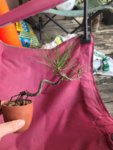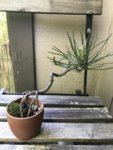As a follow up question, with such small candles would it be best to just let them grow without de-candling in summer?
That is a complicated question. I am assuming that you want to keep the current design and you want to move to refinement (versus development) of your pine.
If you let the tree run, it will be better for the tree, but it will ruin your design of a tiny little exposed root shohin. However if you look at your tree it is really weak. It looks to be about three years old (from seed). There is almost no ramification - you have a total of five candles on the entire tree. In a perfect world you would want to decandle this year and by next year your tree would only be slightly taller, but would have ten candles... etc.
Decandling is a stressful experience for the tree, and the fewer secondary needles are on the tree, the more stressful it is. The tree has to be as strong as possible to push a second set of candles in the growing season. Timing of decandling is critical, as is the timing of your fertilization. You want to fertilize heavily until you decandle, and then hold off fertilizing until the tree has pushed its second set of candles. You want the tree to be as strong as possible so it has the strength to push the new candles, but you don't want to fertilize while the new candles are extending because you will get too much elongation out of them. As soon as the new candles have stopped elongating and have opened you can start fertilizing again.
The sooner you decandle in the spring, the less stressful it is for the tree (as long as it is strong) and the larger the second set of candles will be. If you wait longer (late June or early July), it is a little more stressful for the tree, and the second set of candles will be small. If you wait TOO long (like until August), the tree won't push candles at all, and will only set buds for next year... which in the case of a small tree with few secondary needles could be a death sentence.
So I will be interested to hear what others say, but if it were my tree I would fertilize the heck out of it right now and decandle it in a few weeks (mid/late May). This is early for decandling, and will hopefully not kill the tree. You will be rolling the dice, but it is the only way you will develop ramification while keeping the trunk small and tenuous. Needless to say, do not remove a SINGLE needle that is on the tree currently. You will need every one.
Small exposed root shohin pines are not common for the simple reason that you have to keep the tree on the edge of extinction to maintain the design. If you develop too much ramification, the trunk will thicken too much, and you will have to change your design plans.
Look at this exposed root black pine by Jonas Dupuich. Look at the ramification! At the same time... look at the trunk caliper to support it.






